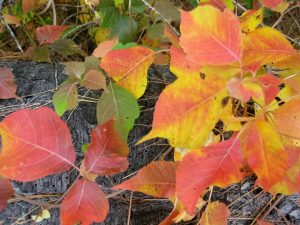Well, everyone knows that, right? Three leaves, reddish, shiny.
Alas. If only it were that simple.
Since poison ivy causes literally millions of humans to develop a nasty, itchy rash, you’d think everyone would know exactly what it looks like. We all recognize and flee the approach of a yellow jacket, wasp, or tarantula. Poison ivy grows right at our feet, in plain view. Why is poison ivy so hard to avoid?
It’s because, sadly, poison ivy is one of the most difficult plants to identify. If only it were bright purple, or had obvious thorns, or something. But poison ivy is like a chameleon, not only changing color but shifting shape as well. Poison ivy’s appearance varies dramatically from place to place and from season to season. The soil it grows in, the amount of sunlight available—all those factors change poison ivy’s disguise. Like snowflakes, no two poison ivy leaves are exactly alike.
They can vary wildly in size. Sometimes the leaves are the size of a dinner plate, sometimes smaller than a dime. This seems to be related to the habitat that the individual plant is found in, whether the area is wet, dry, shady, sunny. For instance, poison ivy plants that grow in densely shaded forests tend to have bigger leaves for maximum photosynthesis. Plants on sunny beach dunes have much smaller leaves.
Then, while there are usually three leaflets on a stem, there can be (rarely) two. Or four. Or seventeen. The leaves are often smooth, but could be fuzzy, hairy, or leathery. Poison ivy can be a vine, twining up a tree, or a ground cover, lurking at ankle-height. It’s enough to drive a botanist crazy.
 Shiny? As ever, poison ivy varies; the leaves can be dull green, often marred with insect bumps and bites. But especially in early summer, I’ve seen poison ivy glistening like silver in the sun. A waxy coating helps keep moisture in the leaves, and can reflect sunlight.
Shiny? As ever, poison ivy varies; the leaves can be dull green, often marred with insect bumps and bites. But especially in early summer, I’ve seen poison ivy glistening like silver in the sun. A waxy coating helps keep moisture in the leaves, and can reflect sunlight.
Red? Yes, in spring the first tiny leaves are a deep garnet red, which fades to greenish-pink as the spring progresses. But in summer poison ivy is a nondescript green, blending in with the neighbors. Then in fall poison ivy puts on its Halloween costume of vivid color—lemon yellow to purple, with shades of red, orange, and gold.
Three leaves? Well, botanically speaking it’s considered one leaf with three leaflets. But I’m sorry to say that dozens of completely harmless species have this pattern. Clover, wild strawberries, raspberry. A young box elder tree (a species of maple) looks so much like PI that it’s sometimes called the poison ivy tree.
Poison ivy, like Cleopatra, is capable of infinite variety.
For more poison ivy fun, check out my book: In Praise of Poison Ivy: The Secret Virtues, Astonishing History, and Dangerous Lore of the World’s Most Hated Plant. https://anitasanchez.com/in-praise-of-poison-ivy/
Identification, tips for healing the itch, and why birds love PI–everything (and more) that you ever wanted to know about poison ivy.
Leaflets Three, Let It Be! A picture book for pre-K to Grade 3, to help the youngest explorers enjoy nature safely.
Take the quiz: can you spot the poison ivy?





Recent Comments